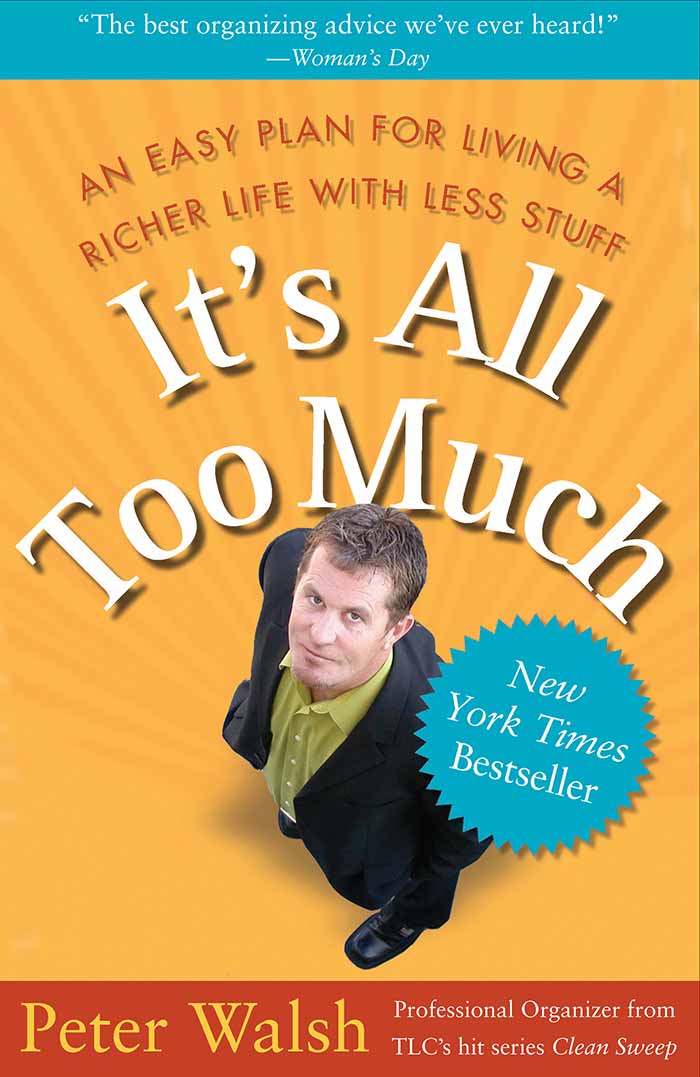It's All Too Much By Peter Walsh

Author: Peter Walsh Title: It's All Too Much ISBN: 9780743292658 Rating: 2/5 Finished: 2014-03-11
I hesitated to read this book because I figured it was for people with serious clutter problems. I spend a lot of time battling clutter and generally win. But, while my house usually appears clean I secretly manage several caches of papers to scan, magazines to review, and clothes to donate. I hoped this book would offer strategies to deal with those last bits of clutter. Unfortunately it didn’t.
The first chapter presents a quiz to determine the reader’s position on a clutter scale. There are a possible 20 points. Your score places you into one of three clutter groups.
00-02 points - Clutter free
03-09 points - Clutter Victim
10-20 points - Hard Core Hoarder
I scored a 10. That’s right, according to Peter Walsh I am a “Hard Core Hoarder”. That my friends is absurd.
Instead of closing it right then, I was actually encouraged by Peter Walsh’s outrageous mis-categorization of me. Surely as a “Hard Core Hoarder” I would find some useful information to help me deal with my sickness, right? Nope.
Walsh spends most of the book describing his interactions with people who sound like borderline if not actual hoarders. He describes people who haven’t used their dining room table to eat dinner in decades. People who have trouble sleeping in their beds because they are filled with their kids toys. People with serious problems. Not only were his strategies for dealing with those problems worthless to me, but I was now really offended to be in the same clutter group as these people.
I also took issue with Walsh’s ambivalence toward recycling or reusing all the junk he helps people remove. He touches on recycling and reuse but notes that most shelters could use cash instead of items. Of course they could. That doesn’t mean you shouldn’t try to keep as much of your junk out of the waste stream as possible. I can understand not wanting to complicate the removal process for people who have real issue detaching. But he never mentions listing things for free on Craigslist which has been an excellent strategy for me. I’ve had lamps, furniture, clothing, books, all picked up within an hour of listing. Plus once you’ve agreed to give the item to someone else it’s gone. I think it’s irresponsible to just throw everything out.
While I didn’t get much from the book it wasn’t entirely useless. Walsh touches on some of the issues I’ve started dealing with now that I have kids. For instance it’s hard for me to recycle my daughter’s artwork even thought I know I can’t keep everything. So I’ll scan it all right? Then it piles up. Then I get a goddamned 10 out of 20 on the test even though the drawings are in a neat pile in my office. These are real issues.
Thinking about my (hopefully normal) emotional attachment to those drawings made me feel really bad for actual hoarders. It must be horrible to feel the same way about junk mail as I do about my daughter’s drawings.
Hopefully this book is helping people with very serious issues. The kind of people whose possessions are limiting the way they can live their lives. But if you’re like me and already fairly conscientious about what comes into your house and what you choose to keep, I doubt you’ll find any groundbreaking revelations here.
Also this book doesn’t have a index. It should have an index. ALL BOOKS NEED AN INDEX.